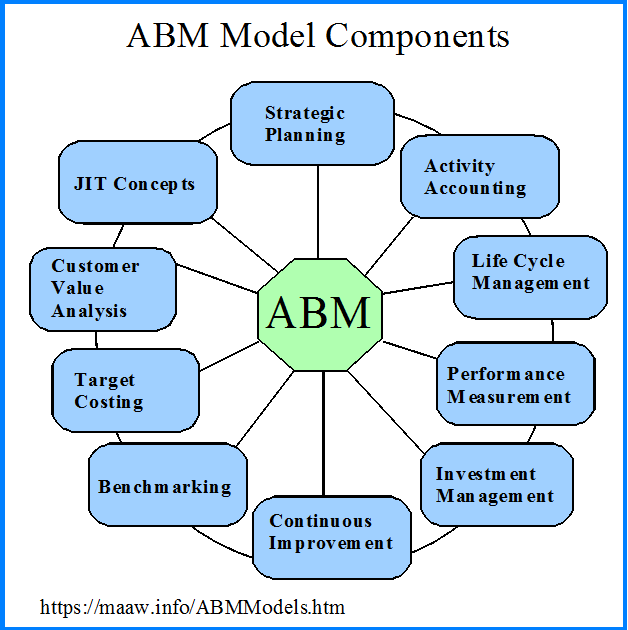
Provided by James R. Martin, Ph.D., CMA
Professor Emeritus, University of South Florida
ABM Main Page | ABC Main Page |
CAM-I Main Page
The CAM-I conceptual design could be described as the first statement of ABM, although the term "Cost Management Systems" was used to describe the project or discipline when the book was published in 1988. The term Activity-Based Management became popular later after Cooper and Kaplan adopted the term "activity-based costing" used in a Harvard Business School case (187-107) about John Deere Company's cost system. The six items in the CAM-I Model below are the concepts that were emphasized in the CAM-I CMS design document.
The CAM-I Model:
1-6 connected for cost management, i.e., CMS Figure
8-14 or from the CAM-I Conceptual Design document:
1. Activity accounting.
2. Strategic planning.
3. Life cycle management including target costing.
4. Performance measures and
5. Investment management.
The CAM-I conceptual design also includes the concept of continuous improvement and tools such as
target costing. See the CAM-I pages for more
details.
Alternative views from Martin and The CAM-I Conceptual Design. - See Figure 8-13
Johnson separated the ABM concept into three main parts pointing out that activity management was process oriented rather than cost oriented. Johnson has frequently argued that activity management involves managing work, not cost. (See the book Relevance Regained). The processes and related work represent the horse, while the costs associated with those processes represent the cart. Don't put the cart in front of the horse and try to manage the costs. Instead, manage the work that people do in the organization.
Johnson’s Model based on six elements as interpreted by Martin:
1. Define Activities.
2. Identify drivers and activity measures.
3. Assign costs to activities.
4. Assign costs from activities to cost objects.
5. Develop performance measurements.
6. Manage processes and work.
Activity costing = 1+ 2 + 3 Activity based product costing = 1+ 2 + 3 + 4 Activity management = 1 + 2 + 5 + 6 Emphasis: Disconnect accounting information (3 and 4) from managing processes. Manage processes not costs. See Figure 8-12
Brimson, Turney and Campi provide other descriptions of ABM. Most of the ideas or concepts that these authors discuss can be found in the CAM-I conceptual design, although each author uses somewhat different terminology.
Brimson’s Model from Chapter C-1, Handbook of Cost Management 1996 edition:
1. Uses ABC as the major source of information.
2. Cost driver analysis.
3. Activity analysis.
4. Key Performance measurement.
5. Includes a continuous improvement perspective (see Exhibit C1.1).
Activity analysis (using organization and process maps), benchmarking, improvement identification, planned improvements, implementation, control of processes, activity based budgeting and earned value reporting.
Turney’s Model from his book Common Cents:
1. Strategic analysis.
2. Value analysis.
3. Cost analysis.
4. Activity-based budgeting.
5. Life-cycle costing.
6. Target costing.
Campi’s Model from Journal of Cost Management article 1992:
1. Activity based costing.
2. Total quality management.
3. Just-In-Time.
4. Continuous flow manufacturing.
5. Employee empowerment.
6. Cellular manufacturing.
7. Focused factories.
For an operational model (or compromise model?) see Figure 8-15. Audiences Exhibit 2-4.

_________________________________________________
Related summaries:
Berliner, C., and J. A. Brimson, eds. 1988. Cost Management for Today's Advanced Manufacturing: The CAM-I Conceptual Design. Boston: Harvard Business School Press. (Short Summary or Concepts.) (Longer Summary.)
Beynon, R. 1992. Change management as a platform for activity-based management. Journal of Cost Management (Summer): 24-30. (Summary).
Campi, J. P. 1992. It’s not as easy as ABC. Journal of Cost Management (Summer): 5-11. (Summary).
Coburn, S., H. Grove and C. Fukami. 1995. Benchmarking with ABCM. Management Accounting (January): 56-60. (Summary).
Cokins, G. 1999. Using ABC to become ABM. Journal of Cost Management (January/February): 29-35. (Summary).
Cooper, R. 1996. Activity-based management and the lean enterprise. Journal of Cost Management (Winter): 6-14. (Summary).
Cooper, R., and R. S. Kaplan. 1998. The promise - and peril - of integrated cost systems. Harvard Business Review (July-August): 109-119. (Summary 1, Summary 2).
Hughes, S. B. and K. A. Paulson Gjerde. 2003. Do different cost systems make a difference? Management Accounting Quarterly (Fall): 22-30. (Summary).
Johnson, H. T. 1989. Professors, customers, and value: bringing a global perspective to management accounting education. Proceedings of the Third Annual Management Accounting Symposium. Sarasota: American Accounting Association: 7-20. (Summary).
Johnson, H. T. 1992. Relevance Regained: From Top-Down Control to Bottom-up Empowerment. The Free Press. (Summary).
Keys, D. E. 1994. Tracing costs in the three stages of activity-based management. Journal of Cost Management (Winter): 30-37. (Summary).
Martin, J. R. Not dated. Chapter 8: Just-In-Time, Theory of Constraints, and Activity Based Management Concepts and Techniques. Management Accounting: Concepts, Techniques & Controversial Issues. Management And Accounting Web. Chapter8.htm
McGowan, A. 1999. Impacts of ABCM on job performance and environment. Journal of Cost Management (March/April): 32-36. (Summary).
Pryor, T. 1997. Making new things familiar and familiar things new. Journal of Cost Management (Winter): 38-42. (Summary).
Reeve, J. M. 1996. Projects, models, and systems -Where is ABM headed? Journal of Cost Management (Summer): 5-16. (Summary).
Sandison, D., S. C. Hansen and R. G. Torok. 2003. Activity-based planning and budgeting: A new approach. Journal of Cost Management (March/April): 16-22. (Summary).
Sweeney, R. B. and J. W. Mays. 1997. ABM lifts bank's bottom line. Management Accounting (March): 20-22 and 24-26. (Summary).
Swenson, D. 1997. Best practices in activity-based management. Journal of Cost Management (November/December): 6-14. (Summary).
Swenson, D. W. 1998. Managing costs through complexity reduction at Carrier Corporation. Management Accounting (April): 20-22, 24, 26-28. (Summary).